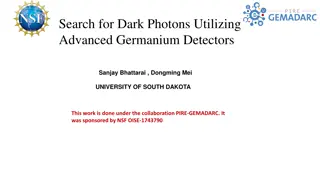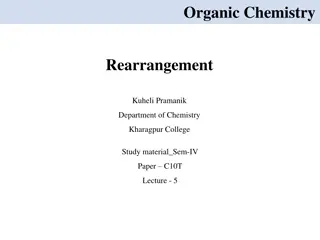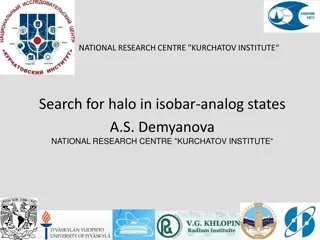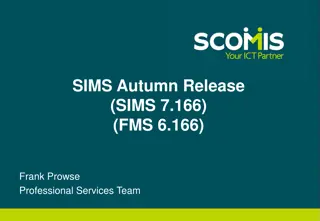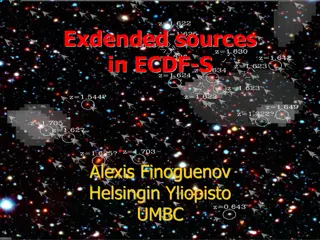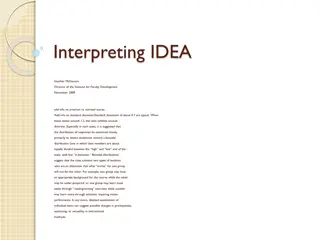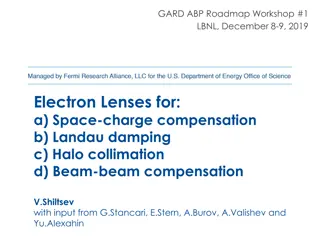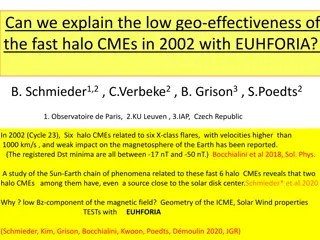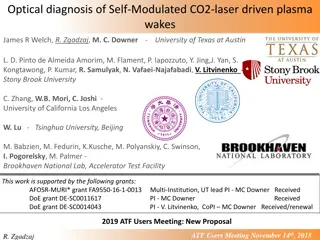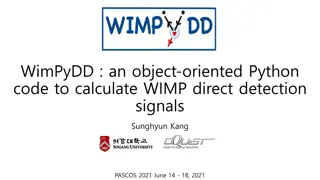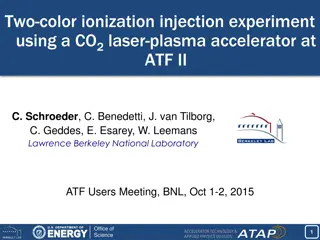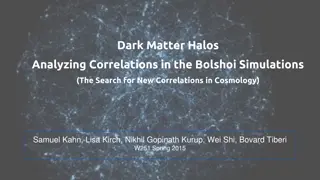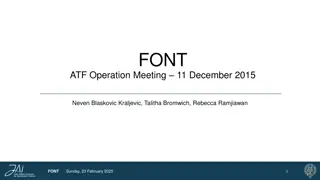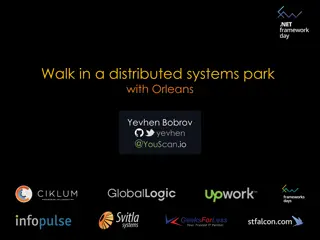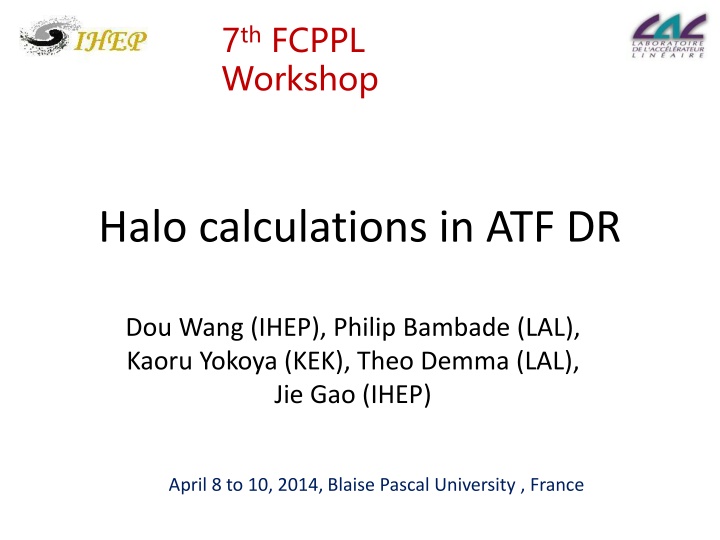
ATF Damping Ring Beam Halo Generation and Distribution Study
Explore the generation and distribution of beam halo in ATF damping ring, investigating main sources like beam-gas scattering and intrabeam scattering. Calculations, theory foundation, and cross-section analysis are discussed, along with beam distribution due to beam-gas interactions at different pressures. The study provides insights into beam dynamics and scattering phenomena in accelerator physics.
Download Presentation

Please find below an Image/Link to download the presentation.
The content on the website is provided AS IS for your information and personal use only. It may not be sold, licensed, or shared on other websites without obtaining consent from the author. If you encounter any issues during the download, it is possible that the publisher has removed the file from their server.
You are allowed to download the files provided on this website for personal or commercial use, subject to the condition that they are used lawfully. All files are the property of their respective owners.
The content on the website is provided AS IS for your information and personal use only. It may not be sold, licensed, or shared on other websites without obtaining consent from the author.
E N D
Presentation Transcript
7thFCPPL Workshop Halo calculations in ATF DR Dou Wang (IHEP), Philip Bambade (LAL), Kaoru Yokoya (KEK), Theo Demma (LAL), Jie Gao (IHEP) April 8 to 10, 2014, Blaise Pascal University , France
Main sources of beam halo generation in ATF damping ring Beam-gas scattering transverse distribution Beam-gas bremsstrahlung longitudinal distribution Intrabeam scattering transverse distribution + longitudinal distribution Table1. Typical ATF parameters Energy E0 (GeV) 1.28 Circumference (m) Nature energy spread 0 Energy acceptance Average x/ y (m) 138 5.44 10-4 0.005 3.9/4.5 Horizontal emittance (nm) 1 Vertical emittance (pm) 10 Transverse damping time (ms) 18.2/29.2 Longitudinal damping time (ms) 20.9 2
Cross section of beam-gas scattering The differential cross-section of the electron scattering with an gas atom is where Z is the atomic number, reis the classical electron radius, is the relativistic Lorentz factor and minis determined by the uncertainty principle as 2 2 1 + Zr Total cross-section: 2 = d d 4/3 2 sin 4 (192 ) Z r e ( ) tot e 2 0 2 2 min min = + 2 2 x 2 y Assuming , make an integration over one direction, one gets the differential cross-section for the other direction 2 2 4 1 d d r Z = e ( ) 3/2 2 + 2 2 min ) ( + 2 min 1 d d ( ) = = ( ) = Probability density 1 f f d ( ) 3/2 0 2 2 min 4 tot
Distribution calculation Assuming the CO gas is dominate for beam-gas scattering in ATF, Z=501/2 and n=2. ( 2.65 10 tot N Q c Q = = (Q Residual gas density , n the number of atoms in each gas molecule, P the pressure of the gas) ) 20 nPa Collision probability during one damping time = N N k ) ( ) f cos( 1 x d 0 2 1 2 k 1 = + 0 ( ) cos( )exp[ arccos( ) ] X kX N x dx dk 2 k x 0 0 xkK ) 1 2 1 2 ( xk 1 = + cos( )exp[ arccos( ) ] kX N x dx dk 1 2 x 0 0 The distribution is decided only by two parameters! N Scattering frequency = = 0 min 0 Minimum scattering angle normalized by angular beam size 5 0
ATF beam distribution due to beam- gas scattering (horizontal) X 1 0.01 104 P=10-6Pa 106 P=10-7Pa 108 P=10-8Pa 1010 Perfect vacuum X 0 2 4 6 8 10 12 6
ATF beam distribution due to beam- gas scattering (vertical) Y 0.1 P=10-6Pa 0.001 P=10-7Pa 105 P=10-8Pa 107 Perfect vacuum Y 0 2 4 6 8 10 12 7
Cross section and tail distribution due to beam-gas bremsstrahlung The differential cross-section of beam-gas bremsstrahlung is 4 3 183 Z 1 1 ) 9 d d = r Z Z + + 2 4 ( 1)( ln e 1/3 where is the energy loss due to bremsstrahlung. 4 3 183 Z 1 9 d d max = = r Z Z + + 2 4 ( 1)( ln )ln max d tot e 1/3 min min ( max is equal to the ring energy acceptance, min is a assumed value.) ) ( 1 1 1 d d max ( ) = = ( ) = 1 f f d Probability density min ln max tot min kx cos( ) E Energy distribution: max 1 d 0 0 min ln max 2 1 2 k 1 min x = + ( ) E cos( )exp[ arccos( ) ] 8 kE N x dx dk 2 0 0
Energy distribution due to beam-gas bremsstrahlung with different vacuum pressure and min Smaller mingive longer tail. Better vacuum pressure give smaller beam halo and larger Gaussian core. 9
IBS cross section for longitudinal direction differential cross section of Coulomb scattering in the center-of- mass system 2 2 16 v c 1 4 v c 4 3 d d r d d r (Small angle scattering) = = e e ( ) ( ) 4 4 4 2 4 sin sin sin The angular change of the momentum gives a momentum component perpendicular to the horizontal axis 2 er dp = 2 d 2 3 p v ) and is the momenta p Where is the c.m. velocity of the electrons in units of c ( exchange from horizontal direction to the perpendicular directions in the center-of- mass frame. probability is same for transfers occurring in the vertical and longitudinal directions. = 2 c Total events of momenta exchange from horizontal direction to longitudinal direction per second: 2 4 cr N d d = cP x x d dx dx ( , ) e e N 1 2 1 2 2 3 2 6 P min ' x y z x min P Probability density function: 2 2 1 P d d ( ) = = f min 3 10 tot
Energy distribution due to IBS kx 2 min 2 cos( ) E E ) 1 ( d 0 0 2 1 2 k 3 1 E = + ( ) E cos( )exp[ arccos( ) ] kE N x dx dk min 2 x 0 0 Emin=0.01% 11
vertical distribution due to IBS kx 2 2 cos( ) P p y min ' min P y ) 1 ( dp y 2 3 1 2 k p 1 y = + ( ) Y cos( )exp[ arccos( ) ] kY N x dx dk 2 x 0 0 12
Comparison with beam-gas scattering effect ATF vacuum pressure: 10-7 10-6Pa IBS Beam-gas scattering In ATF damping ring, vertical distribution is dominated by beam-gas scattering??? 13
Comparison with experiment From experiment results, charge intensity of vertical halo is about 4 order lower than beam center. Agree with Beam-gas scattering analysis consider some new measurements of halo using different vacuum pressure in the ATF DR 14
IBS simulations by CMAD -check converge time and emittance Input equilibrium horizontal emittance x=1.08E-09 mrad, vertical emittance y=5.8E-12 mrad, bunch length z=6.0E-03 m, energy spread =6.0E-04 and bunch charge Ne=1E10 We did 4 modes simulations to get convergence for: 1) 1000 times shorter damping time and 1000 times higher charge, 2) 100 times shorter damping time and 100 times higher charge, 3) 50 times shorter damping time and 50 times higher charge, 4) 10 times shorter damping time and 10 times higher charge. By this way we could check if the values of the emittance become closer to the expected ones. If they do, it could be a useful parameter set for future testing, including for the halo tails. 15
600turns_1000times (converge after 150 turns -4 x) Tracking time with 16 cpus: 3 hours 16
6000turns_100times (converge after 1500 turns -4 x) Tracking time with 16 cpus: 0.8 days 17
10000turns_50times (converge after 3000 turns -4 x) Tracking time with 16 cpus: 1.4 days 18
10000turns_10times (converge after 15000 turns -4 x) Tracking time with 16 cpus: 1.4 days 19
Comparison with ATF beam measurements From Kubo s paper From Jie Gao s paper 20
Summary and future plan An analytical method to give the estimation of ATF beam halo distribution due to beam-gas scattering, beam-gas bremsstrahlung and intra-beam scattering, based on K. Hirata and K. Yokoya s theory, was developed. This method is rather common and can be applied on other electron rings. The study of IBS effect with different horizontal emittance is going on. Horizontal distribution due to IBS needs further study. For horizontal distribution, it s more difficult because there is coupling effect between longitudinal and horizontal. IBS simulations were done by CMAD. Horizontal emittance does not agree with the experiments. We are trying to understand and update the source code. How can we use CMAD to make halo study? 21
References 1. Dou Wang, Philip Bambade, Kaoru Yokoya, Jie Gao, Analytical estimation of ATF beam halo distribution , http://arxiv.org/abs/1311.1267v2. 2. Kohji Hirata and Kaoru Yokoya, Non-Gaussian Distribution of Electron Beams due to Incoherent Stochastic Processes , Pariticle Accelerators, 1992, Vol. 39, pp. 147-158. 3. Taikan Suehara et. al., Design of a Nanometer Beam Size Monitor for ATF2 , http://arxiv.org/abs/0810.5467v1. 22



